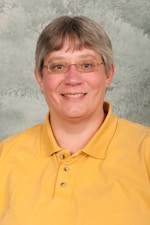Jean Standard

- About
- Education
- Selected Research
Current Courses
CHE 466.091 Computational Chemistry
Teaching Interests & Areas
Physical Chemistry I & II Computational Chemistry Quantum Chemistry Methods of Computational Science
Research Interests & Areas
Research in my group is in the area of computational chemistry. The major themes of my research include the study of weakly bound systems, such as van der Waals molecules and hydrogen-bonded complexes; investigations of the dynamics of wide-amplitude and highly-excited molecular vibrations; probing of photodissociation and other decay processes in small molecules; and the investigation of metastable states of atoms and molecules. Understanding vibrational dynamics and photodissociation processes requires a knowledge of potential energy surfaces for the molecular system of interest; therefore, we also are engaged in developing methods for determining potential energy surfaces for small molecules and complexes. Students in the group generally will be involved in running several different simulation and computer graphics programs on Unix workstations. Techniques employed include a variety of quantum and classical mechanics methods. Though computer programming experience is not required to work in the group, students with programming experience may also be involved in developing computer programs. Listed below are a few current projects. (1) Atmospheric Sulfur Chemistry Sulfur emissions into the earth's atmosphere consist primarily of sulfur dioxide, SO2, from fossil fuel combustion. Sulfur dioxide is oxidized to sulfur trioxide, which is then converted into sulfuric acid, H2SO4, one of the principal components of acid rain. One set of steps in the mechanism involves oxidation of sulfur dioxide to sulfur trioxide, SO3. Sulfur trioxide then reacts with water to form an intermediate molecular complex, SO3–H2O. The molecular complex rearranges to form sulfuric acid, H2SO4. It is believed that the activation energy required for conversion of the intermediate complex to acid rain is reduced significantly by the presence of additional water molecules. We are investigating the effects that additional water molecules have on the structure and energetics of acid rain precursors using a variety of quantum mechanical methods. (2) Interactions of Singlet Carbenes with Heteroatom-containing Compounds For the past few years, my research group has been involved in carrying out computational studies of singlet carbenes and intermolecular complexes formed from singlet carbenes, such as ylides. Ylides are formed from the interaction of molecules containing a heteroatom (such as N, P, O, S, F, or Cl) with a singlet carbene molecule. Such intermolecular complexes are often difficult to study experimentally, due to their short lifetimes and high reactivity. Sulfur ylides are formed when a molecule containing a sulfur atom interacts with a singlet carbene. The lone pair electrons on the sulfur interact with an empty orbital on the carbene. Sulfur ylides are important symthetic intermediates which have recently been employed in the production of designer polymers and the formation of metal-carbene complexes. High-level, large-scale computational studies of sulfur ylides are being performed in order to investigate their structures, properties, energetics, and bonding. (3) Computational Studies of Alkanethiols Chemisorbed on Noble Metal Surfaces Alkanethiols chemisorbed on noble metal surfaces form self-assembled monolayers (SAMs), which consist of densely packed hydrocarbon chains bound to the surface through a covalent interaction between sulfur headgroup and metal surface. Experimental observations of surface-enhanced electronic Raman scattering (SEERS) have been made for alkanethiol SAMs on roughened silver and gold surfaces. In conjunction with Professors Brian Clark and Brian Gregory, we have shown that the electrons involved in SEERS are located in the vicinity of the sulfur headgroup region. Therefore, the electronic structure of the headgroup region plays a key role in understanding the energetics of the alkanethiol SAM systems. Because the recent modeling studies suggest that the electron is localized in the headgroup region, the electronic structure and bonding of the sulfur interacting with the metal surface must be elucidated. In this project, ab initio quantum mechanical calculations are being carried out to obtain a wealth of information about the electronic structure of the system. The focus of the project is two-fold: first, high-level studies are being completed to investigate the interactions of thiolate (and selenate) species with small gold and silver clusters; second, electronic structure calculations are being performed to determine the interactions of two or more thiolate species on larger gold and silver clusters.